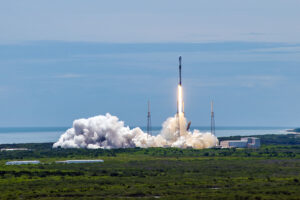The Falcon 9 launched the Lockheed Martin-built GPS 3 Space Vehicle 5 — the 5th satellite of the GPS 3 constellation that provides positioning, navigation and timing signals to military and civilian users.
With this launch, the Space Force officially enters the era of reusable rockets. GPS 3 SV-5 was the first National Security Space Launch mission where SpaceX used a previously flown Falcon 9 first stage. The booster — designated B1062 — was recovered Nov. 5 after the launch of GPS 3 SV-4.
The rocket’s first stage separated from the second stage approximately two minutes and 40 seconds after liftoff. About eight minutes and 35 seconds after liftoff, the Falcon 9’s first stage touched down on the “Just Read the Instructions” droneship off the coast of Florida in the Atlantic Ocean.
The booster landing was the third time SpaceX recovered the Falcon 9 first stage in a National Security Space Launch mission and the 88th successful recovery of a first stage by the company.
After two second-stage engine burns, the GPS satellite separated approximately one hour and 29 minutes after liftoff. SpaceX confirmed it was a successful orbit injection.
The GPS 3 SV-5 satellite will join the constellation of 31 spacecraft that operate in medium Earth orbit at an altitude of 12,550 miles in six orbital planes. Each satellite circles the Earth twice per day.
The June 17 mission was SpaceX’s fourth launch of a military GPS 3 satellite under the National Security Space Launch program. The first was on Dec. 23, 2018, the second and third took place on June 30 and Nov. 5, 2020.
The company is under contract to launch GPS 3 SV-6 next year.
Col. Robert Bongiovi, the director of the Space Force Launch Enterprise, said SpaceX will continue to fly reused boosters in national security missions.
“We are building on the successful booster recoveries of GPS 3 SV-3 and GPS 2 SV-4 last year and making a historic step with the GPS 3 SV-5 mission using a previously flown vehicle,” he said. “The affordability and flexibility provided with SpaceX’s reused launch vehicles open additional opportunities for future NSSL missions.”



